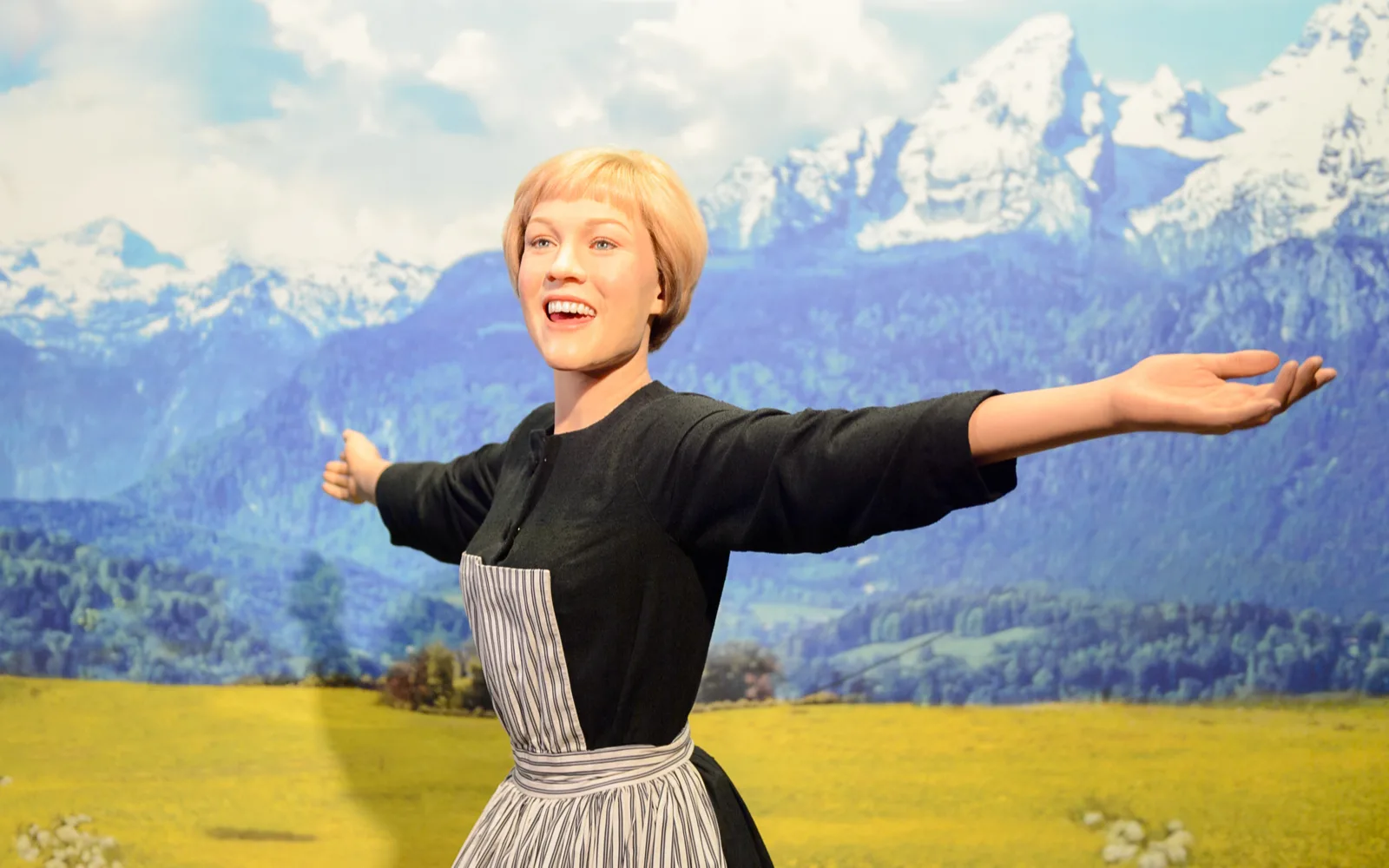After “The Sound of Music” debuted in 1965, it didn’t just capture hearts; it sparked a travel frenzy. Fans eager to step into the movie’s world began flocking to Austria, drawn to the enchanting filming locations like Schloss Leopoldskron and the charming Hellbrunn Castle Gazebo.
These spots, along with the picturesque Mirabell Palace and the historic Nonnberg Abbey, are more than just movie sets; they’re windows into a rich cultural and historical tapestry. For those visiting, it’s a chance to walk through the scenes of their favorite film and touch a piece of history. Learn how you can do the same below.
Following its release in 1965, The Sound of Music was met with instant success. The hills were alive with people singing the songs, and tourist centers were quickly full of people wanting to visit Von Trapp’s Austria.
It wasn’t long for a Sound of Music tour to become a staple destination for anyone in the area. But to plan yours, the best place to start, as the song says, is at the very beginning.
Sound of Music Filming Locations to Visit in 2025
In addition to the beautiful music, The Sound of Music is rife with spectacular scenery and beautiful interiors. That can make it hard to narrow down what film locations to visit when planning your trip.
These are some of the most memorable, and most popular Sound of Music film locations. Every fan should see them at least once. You may not get to all of them, but they’ll help you decide which places to prioritize.
1. Schloss Leopoldskron
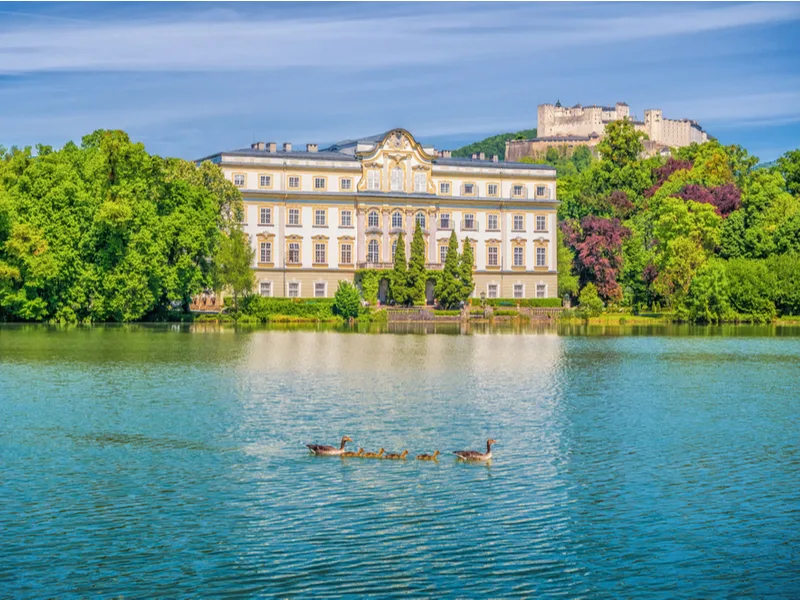
Canadastock/Shutterstock
Schloss Leopoldskron has a rich, complex history and an eclectic list of owners. It began life as the home of Archbishop Leopold Count Firmian in 1736.
Almost 100 years later, the Archbishop’s family sold the estate, and from 1837 onwards, the palace changed hands regularly. The King of Bavaria owned it briefly. But by 1918, when writer Max Reinhardt acquired it, it was dilapidated.
Reinhardt renovated and overhauled the building, restoring it to its original rococo majesty. The upkeep for the palace was considerable, however, and since 1958 it’s belonged to the Salzburg Seminar in American Studies.
Despite the Salzburg Seminar’s interest in the economy, the house was still the natural choice when it came to shooting the Von Trapp family home. The back of the palace was shot and used for exterior and establishing shots of the house.
In addition to the exterior shots, several key scenes take place on the Leopoldskron grounds. These include:
- Lemonade with the Baroness
- Maria and Georg’s balcony dance
- The children’s tumble into a nearby lake
Additionally, the Venetian room features prominently. No one filmed scenes in it, but the interior was reproduced in-studio and became a significant set for various Von Trapp drawing room scenes.
2. Hellbrunn Castle Gazebo
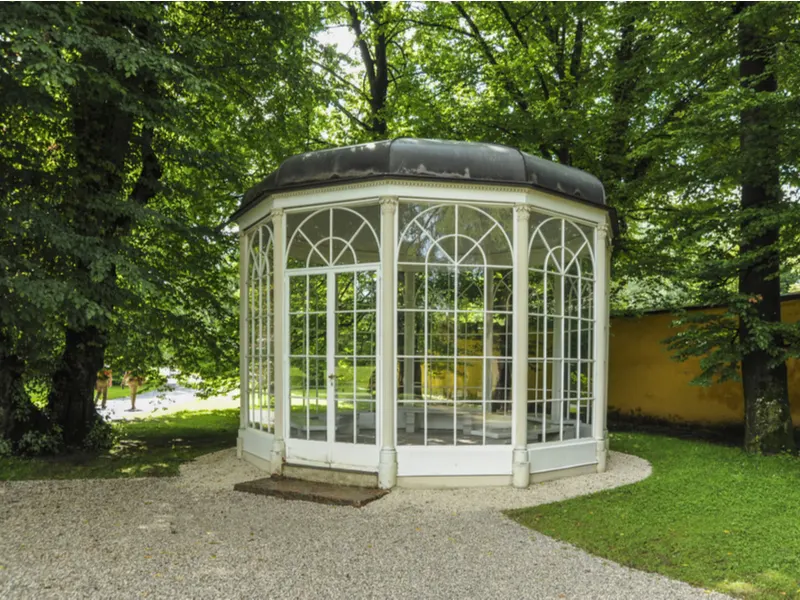
ZC_Photography Concept/Shutterstock
You wouldn’t expect an anonymous gazebo to make the list. The Sound of Music wasn’t the first film to use one, and, as fans of Sullivan’s Anne of Green Gables films attest, it wasn’t the last to capitalize on the romantic appeal of these picturesque, open-air locals.
The gazebo at Hellbrunn Castle has the distinction of featuring in two romantic moments in The Sound of Music. Viewers first see it as young Rolf courts Lisel to the tune of Sixteen Going on Seventeen.
The youthful love affair is a doomed one, so it’s as well this spot gets a second chance at matchmaking. It reappears when Maria and Georg teach the children to waltz, and this time the music is Something Good.
However, the Hellbrunn gazebo isn’t the original. When filming ended Sound of Music tours gained popularity, and the gazebo was rebuilt and renovated for Hellbrunn. The original is in the gardens of Schloss Leopoldskron, but visitors favor this one because it’s easier to access.
3. Mirabell Palace and Garden
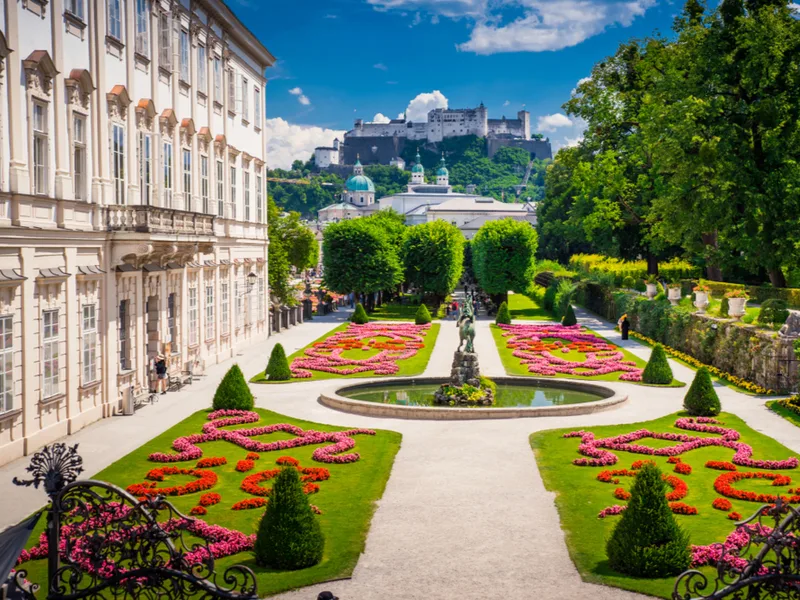
Kovop58/Shutterstock
Whether you’re looking for an impromptu singing lesson or a stroll through a grand house, Mirabelle Palace is the place to go. Built in the 18th century, the palace was the brainchild of famous architect Fischer von Erlach.
Its grounds and interiors are rife with allusions to Greek mythology. The most notable of these is a Pegasus fountain. Memorably, it’s the Sound of Music filming location used for the song Do-Re-Mi.
Keen-eyed viewers can spot Maria and the children singing and dancing around the winged horse at the heart of the garden. But you can also spot several other statues in shots that have them running down the avenue towards the fountain.
Viewers who enjoy their Classics as much as their Sound of Music can pause the film and guess at the mythology behind these statues, though you have to interrupt the music to do it.
4. Mehlweg Mountain
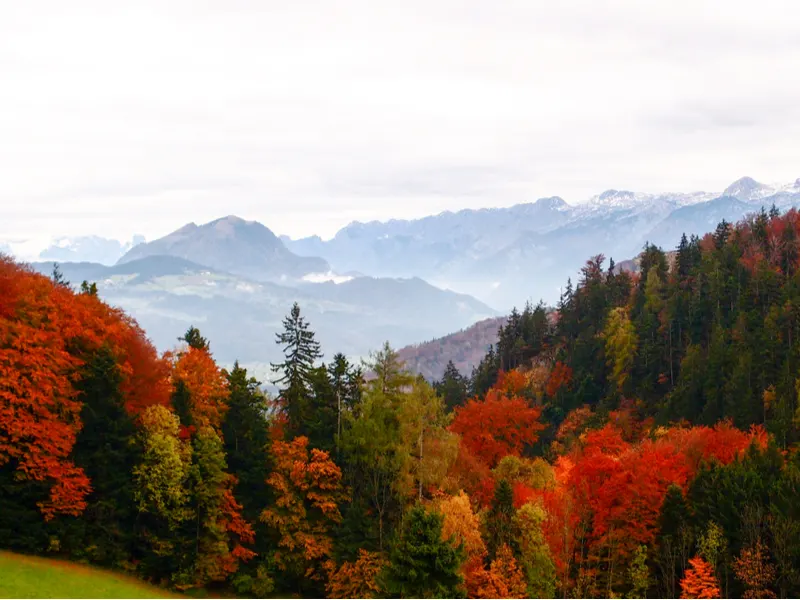
Zcenerio/Shutterstock
If you’re an adventurous soul with a love of the outdoors, consider adding Mehlweg Mountain to your tour of Sound of Music film locations.
Viewers will know it immediately as the mountain backdrop that gives Maria her famous, whirling-dervish entrance into the musical. The film location is approximately six miles from Salzburg and close to Markt Schellenberg.
If you do go up the mountain, keep in mind that the brook that famously trips and falls through those opening scenes doesn’t exist. Neither do the birch trees Maria swings around. Production added them later to embellish the already stunning scenery.
5. Kloster Höglwörth
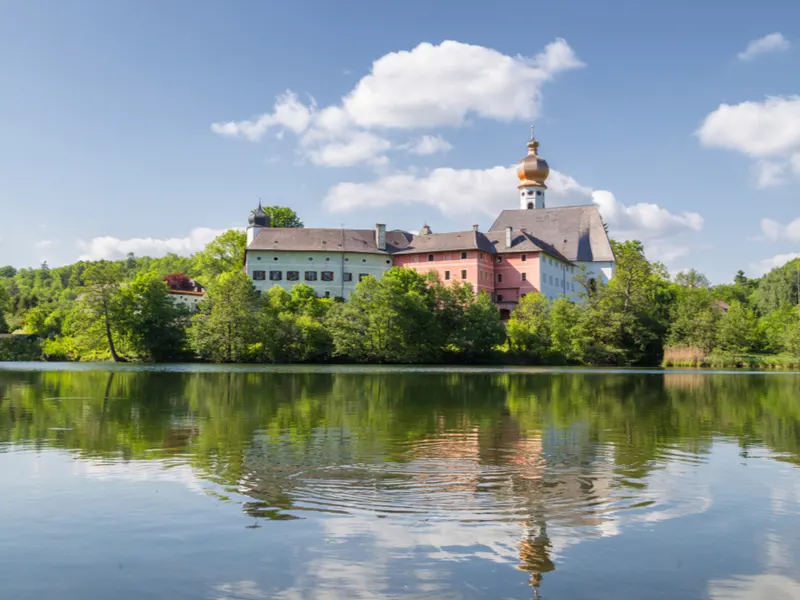
Canadastock/Shutterstock
Talking of that opening sequence, two lesser-known Sound of Music film locations are the castles you see overhead as the aerial camera sweeps over the Salzburg landscape.
These castles are Schloss Anif and Kloster Höglwörth. As the name suggests, Kloster Högelwörth is an old monastery. It dates back to the 12th century. Built in 1125, the abbey is dedicated to Apostles Peter and Paul.
One of the distinctions of this cloister is that, unlike many other monasteries of its time, it emerged unscathed from the secularization of Bavaria.
The monastery sits on Lake Högelwörth. It’s changed since the twelfth century and today features the attributes of the rococo style typical of its renovation in 1675. However, the original choir survives.
6. Schloss Anif
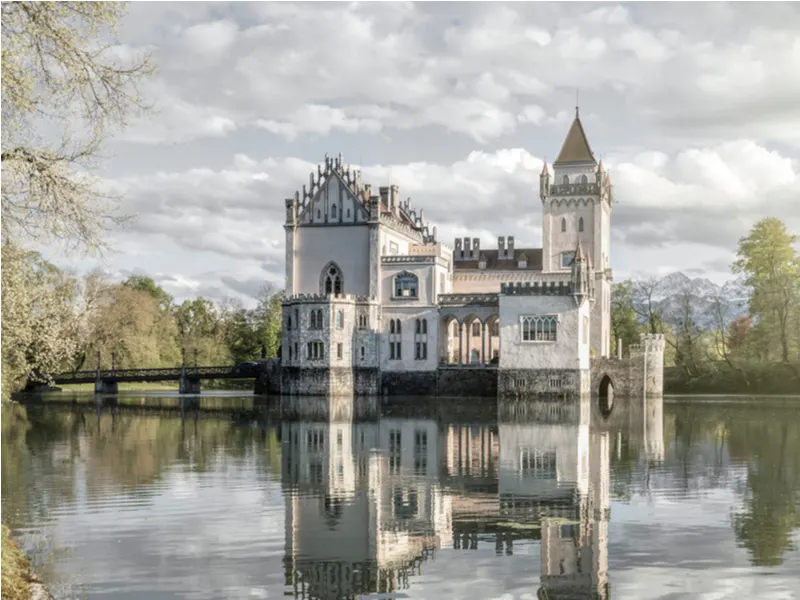
mRGB/Shutterstock
Schloss Anif sits on the southern edge of Saltzburg and overlooks an artificial pond. For this reason, it sometimes gets called The Water Palace. This also has an ecclesiastical history since it used to be the residence of the Bishop of Chiemsee.
Later, it developed a secular purpose and functioned as a nineteenth-century court. Schloss Anif underwent several renovations. One in 1834, and then again in 1848, and today has a neo-gothic appearance.
In addition to being a Sound of Music film location, you can spot The Water Palace in several other films, including:
- The Great Race
- The Odessa File
7. Nonnberg Abbey
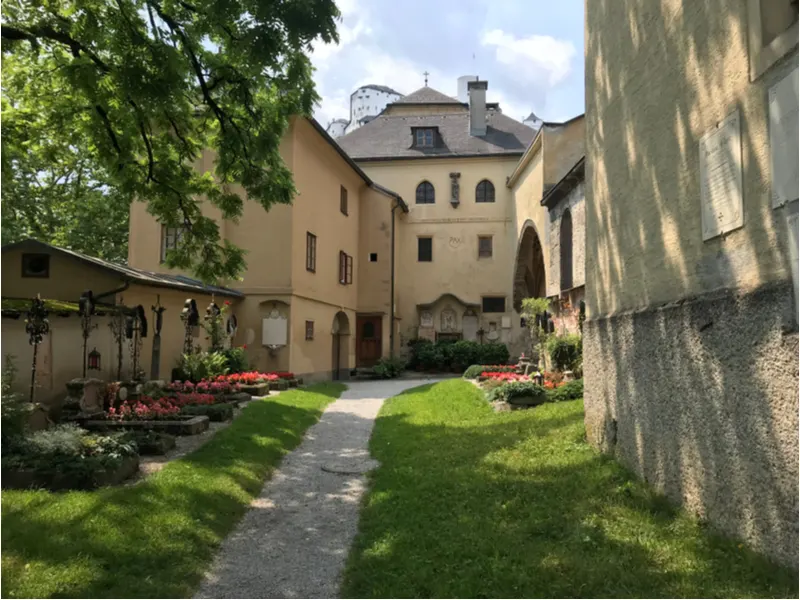
MarMilad/Shutterstock
If you want to solve a problem like Maria, then Nonnberg Abbey is the place to visit. Nonnberg Abbey was the Sound of Music film location used throughout the production for Maria’s convent scenes.
Remarkably, Nonnberg Abbey reaches further back in history than any other film location on this list. Founded in 714, it’s the oldest women’s convent this side of the alps.
Inevitably for any church, it had several near misses due to fire and shifting religious politics but always lived to tell the tale. The version visitors see today isn’t the 714 model but still quite old, dating back to the seventeenth century.
If you visit, don’t be surprised to find the view less impressive than Maria’s convent. The real thing overlooks not the Salzburg proper but the suburbs.
The film similarly plays fast and loose with the Abbey interior, possibly because filming in churches can be challenging to light effectively. Instead, the studio recreated the Abbey interior. If you decide to peek inside the chapel, you’ll notice the copy is nothing like the original.
Despite all the liberties The Sound of Music takes with this particular film location, several pivotal moments transpire at the Abbey and were filmed on location. These include:
- The children’s visit to Maria at the convent
- Escape sequence involving the Von Trapps and Nazis
- Mass in the opening sequence
- Nuns’ performance of Maria
This last transpires in the Abbey courtyard.
Whatever the discrepancies, Sound of Music fans will appreciate that Nonnberg Abbey, while not accurate on-screen, played a real and crucial role in the life of the Von Trapps, whose story inspired the film.
Maria Von Trapp did originally present to Nonnberg as a novitiate candidate, and she was subsequently married to Captain Von Trapp a the same Abbey in 1927.
8. Summer Riding School
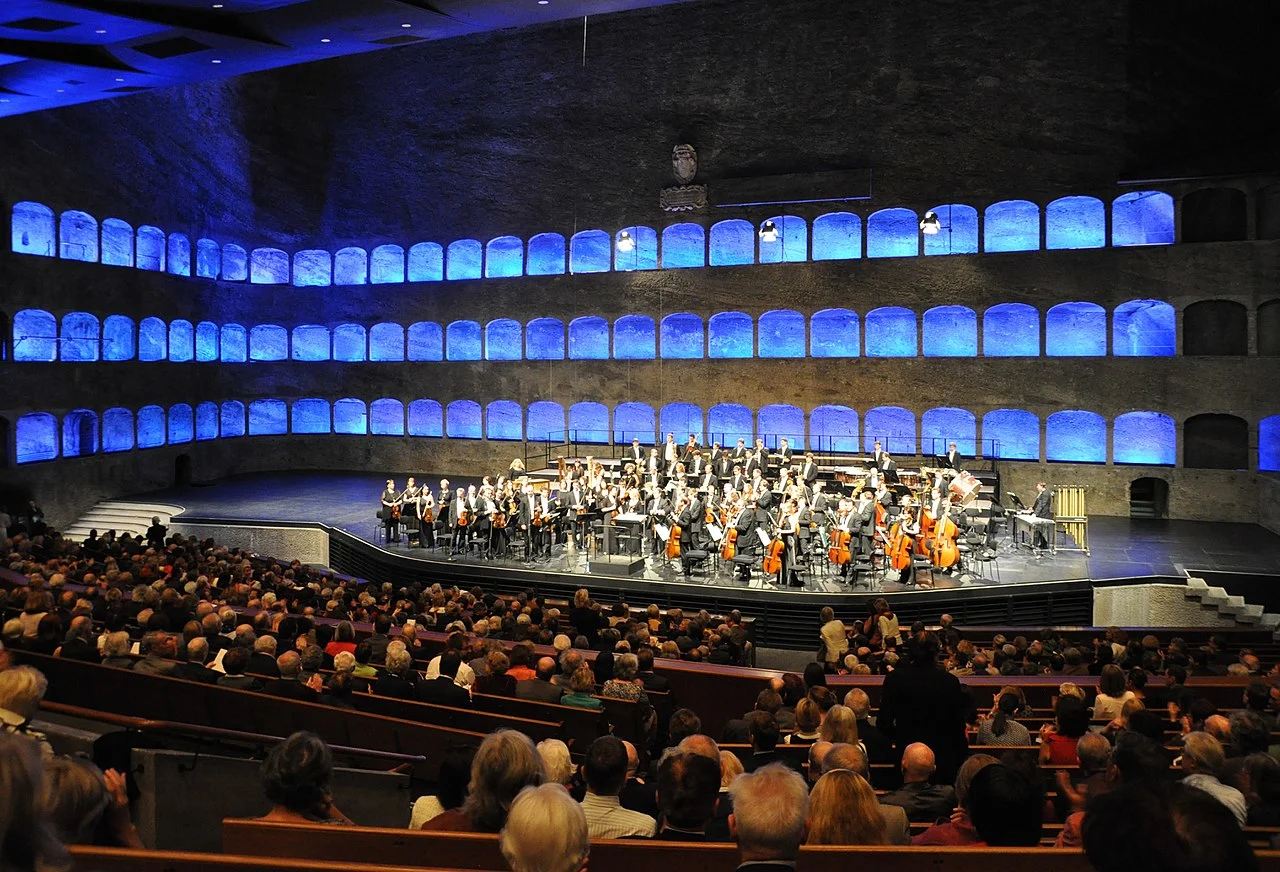
Andreas Praefcke / wikimedia.org
You don’t tend to think of horses when looking for Sound of Music film locations. And admittedly, the association is an unlikely one. The riding school makes its appearance in the film not as itself, but as originally intended.
The Von Trapp Family Singers compete in Uncle Max’s music festival. Memorably Christopher Plummer’s Georg buys his family time with a rendition of Eidelweiss while the rest of the family implements escape plans.
Interestingly, the Summer Riding School wouldn’t exist but for the building of the Salzburg Cathedral. Cutting boulders from the Mönchsberg left a vast crater where the Riding School now stands.
Archbishop Johann Ernst von Thun turned that cavernous space into a riding school and tournament location in 1693. These days jousting is out of fashion, and the Summer Riding School functions as a theater.
9. Salzburg Old Town
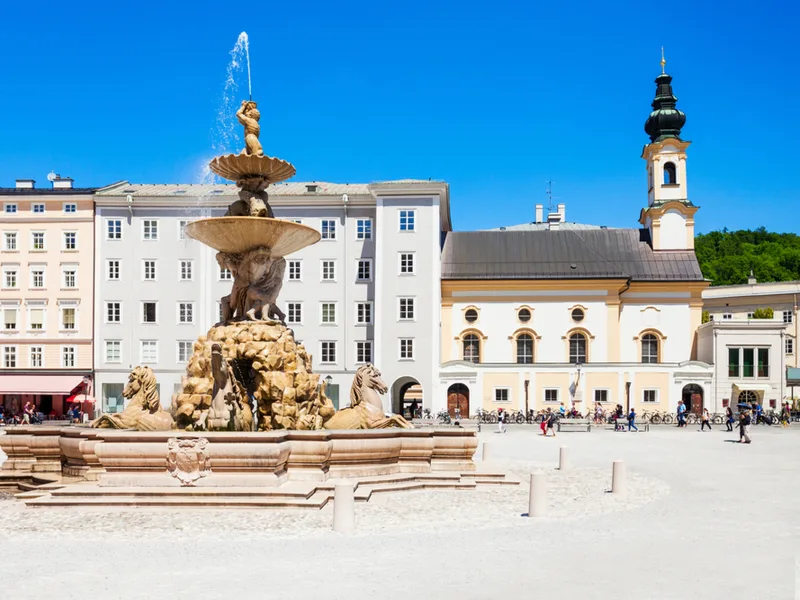
Saiko3p/Shutterstock
Another film location you can’t miss when touring Sound of Music scene backdrops is Saltzburg’s Old Town. The Residenzplatz is particularly distinctive.
From there, you can see the Domplatz arches Maria dances through while singing I Have Confidence. It’s also the home of the Residenzplatz fountain, where she stops to splash the water.
10. St Peter’s District
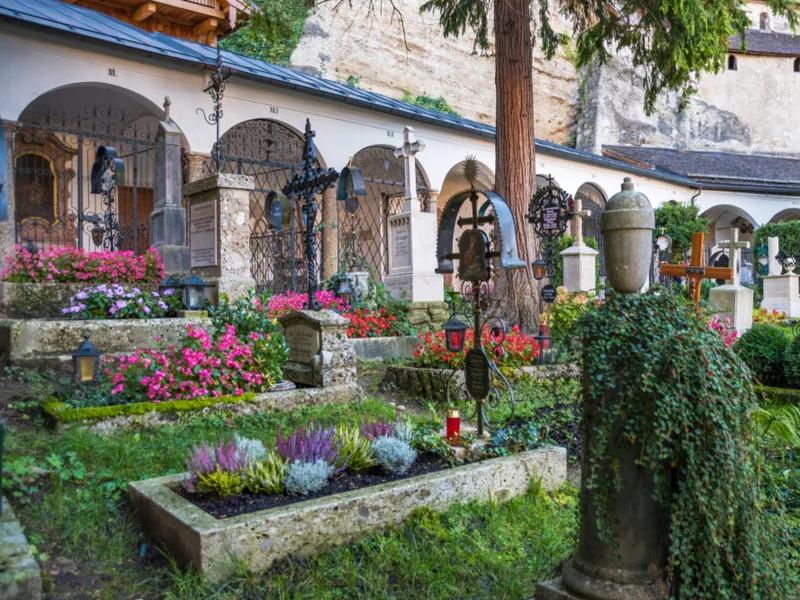
Bernard Barroso/Shutterstock
The exterior Salzburg shots in The Sound of Music comprise various parts of the old town, and St. Peter’s District is one of these. It’s the oldest part of the city. When monks arrived in Salzburg, this is where they set their monastery.
The rest of the city grew around it. The part of St. Peter’s that’s significant to Sound of Music film location experts, though, is the graveyard. It’s where the monastery buried its monks until approximately 1454.
It also has a collection of eighteenth-century vaults that house some of the older Salzburg family relics.
The vaults have stunning ironwork, but what’s interesting about the cemetery is that it’s still operational. The Sound Of Music connection comes in here. St Peter’s is the graveyard with its arcades and ironwork that inspired the Hollywood set designers.
They didn’t shoot on location for the graveyard scenes, though. Instead, they built a graveyard set back in Hollywood that took St. Peter’s as inspiration and shot the Nazi chase scenes there.
The other reason to visit St. Peter’s District is for the church of the same name. Eagle-eyed viewers will spot it as the camera swoops over the city in the opening film sequence.
11. Frohnburg Palace
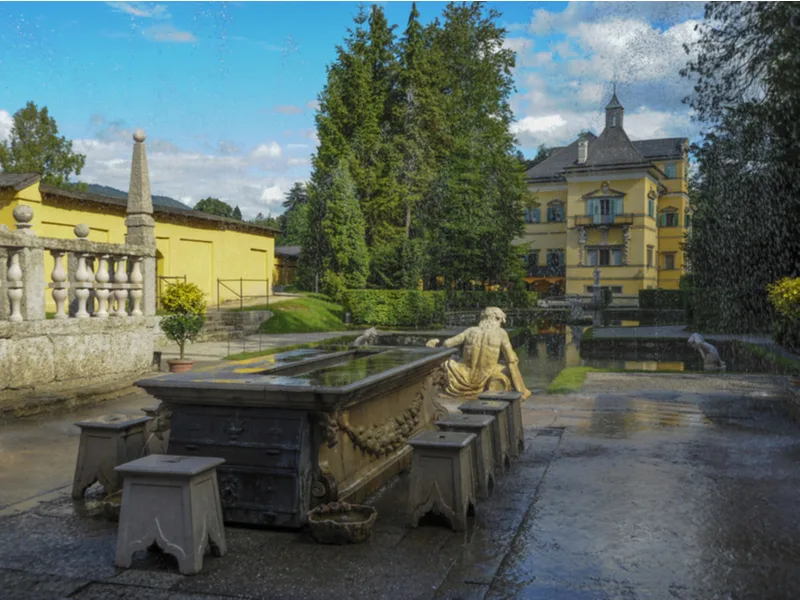
zc_Photography Concept/Shutterstock
We talked earlier about the role Schloss Leopolskorn played in establishing the Von Trapp family home on screen. But it wasn’t the only building instrumental to creating the home of the Captain and his children.
It’s Frohnburg Palace you see as Maria alights from the bus stop after I Have Confidence. She walks along the Hellenburg Alley to get there, which is a bit of a mismatch of Salzburg places, but you don’t notice in the editing.
It’s also the imposing Frohburg Palace gates that give Maria a moment’s hesitation before she marches up to the house. And although the Schloss Leopoldskron does appear in many exterior shots, so does Frohnburg Palace.
Scenes shot here include:
- The Baron tearing the Nazi flag in two
- Von Trapp family pushing the car noiselessly out of the gate to avoid detection
Built in the eighteen century, it’s another location with a history of housing Archbishops. Unlike Schloss Leopolskron, it wasn’t a permanent home. Instead, it was a country retreat for Archbishops and their family that wanted time away from the city center.
Today’s Archbishops have less need for country homes, so now Frohnburg Palace houses music students from the Mozarteum Music Academy. Given the exterior’s role in The Sound of Music, that seems apt.
12. Villa Trapp
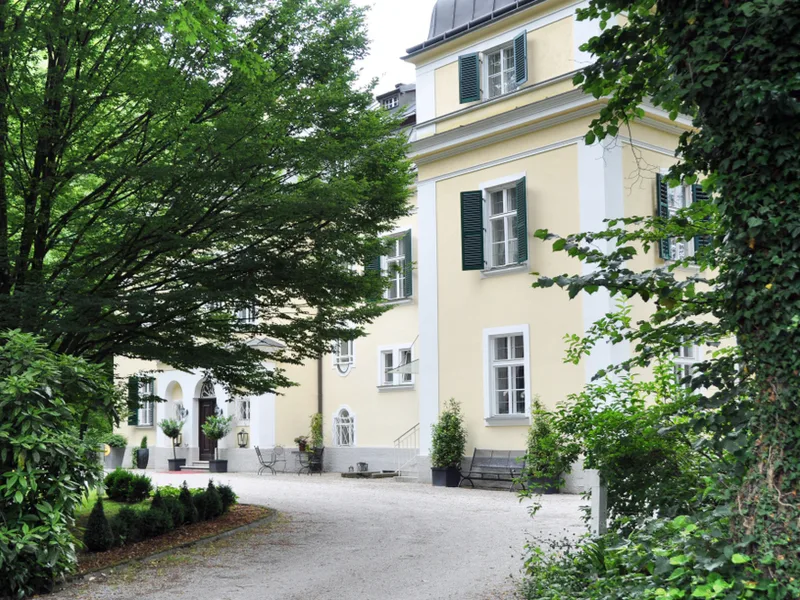
Glimpse of Sweden/Shutterstock
We’ve now discussed both film locations for the Von Trapp house as they appear in the film. But visitors familiar with the history and the memoir recounting the story behind the movie may also find it interesting to visit the original Villa Trapp.
Today the house operates as a hotel. It’s in Aigen, not quite the Old Town of Salzburg seen in the film, but nearby and accessible by train.
13. Mondsee Abbey
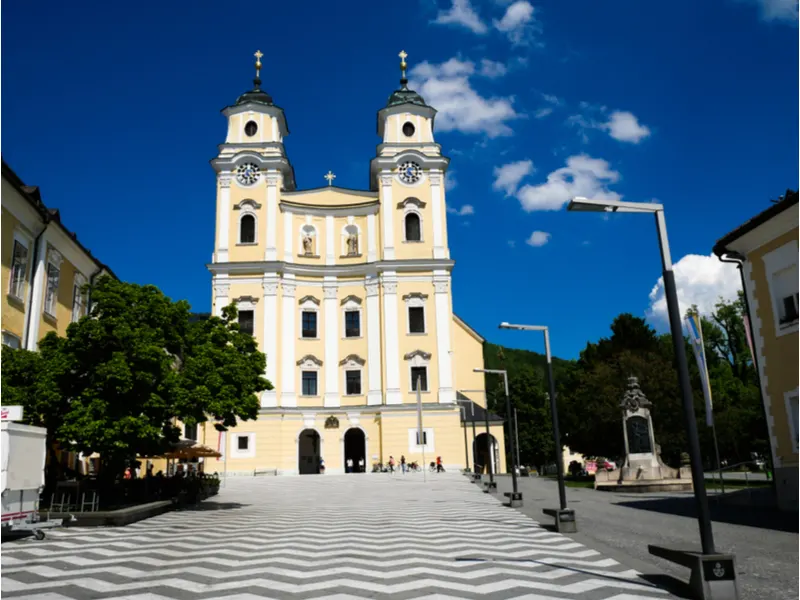
Ricardo Vallejo Vieira/Shutterstock
Mondsee Abbey is another religious building to put on your list of Sound of Music film locations. Although much of the convent scenes revolve around or were inspired by Nonnberg Abbey, there’s one notable exception.
Despite the film’s insistence, Maria marries her Captain at the convent she previously called home, the interior used isn’t Nonnberg Abbey. It’s not even inspired by Nonnberg. Maria’s wedding and the background you see there is the basilica at Mondsee Abbey.
This is a completely different Abbey. Built in 748, it’s only slightly younger than Nonnberg Abbey. Somewhere along the way, it became an Imperial property.
There follows a confusing tangle of history where the building gets passed between Bavaria and Austria as if it’s a parcel in pass-the-parcel. It became particularly confusing during the Napoleonic period.
Although the surrounding area became Austrian, the Abbey stays in Bavarian hands.
But, if the history proves too hard to grapple with, you can enjoy it for its architecture and filmography connection. It’s a stunning Abbey with a remarkable interior, whoever it belongs to.
A bit of trivia for film lovers: The wedding scene as filmed in Mondsee was one of the first scenes shot for The Sound of Music.
14. Hohenwerfen Fortress
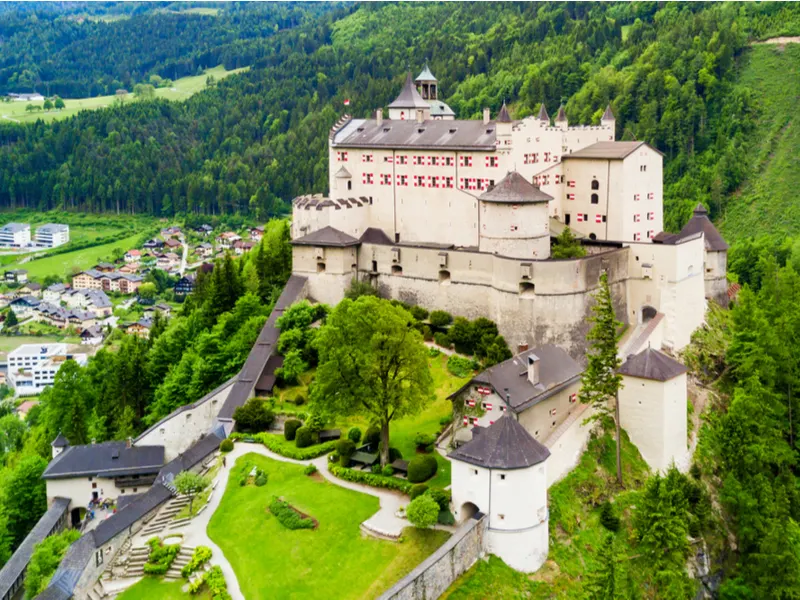
saiko3p/Shutterstock
Hohenwerfen Fortress isn’t in Salzburg, but it’s still worth a visit. Archbishop Gebhardt von Hammerstein built it in 1077 as part of an attempt to protect the Salzburg basin.
It makes a spectacular backdrop for part of the Do-Re-Mi musical sequence. It’s also the place to go to explore the famous Giant Ice Caves.
They have a notoriously high ceiling, and musically-minded tourists can take the opportunity to test the acoustics. We have confidence music in there would sound remarkable.
15. Town and Lake Mondsee
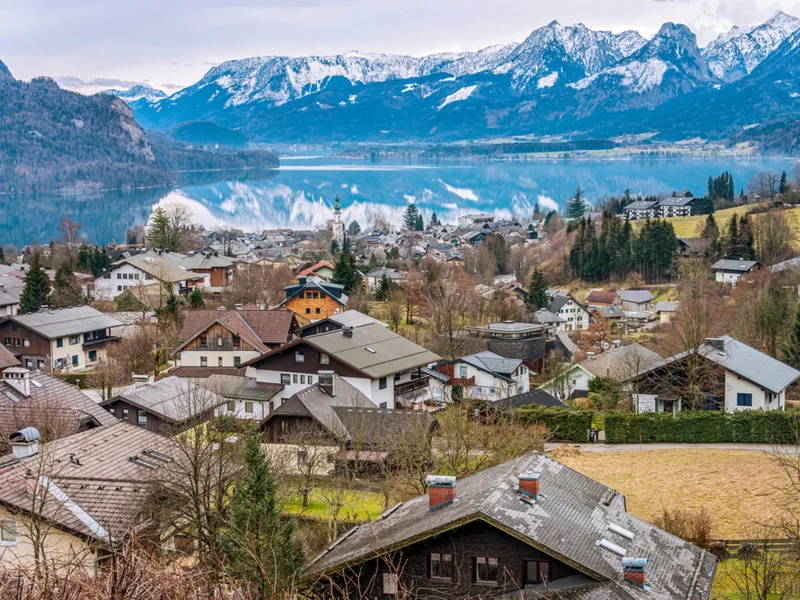
Wagner Santos de Almedia/Shutterstock
While there’s no obvious Sound of Music film location connection here, as long as you plan on visiting the Mondsee Abbey, take the time to look at the surrounding village and lake.
It has a vibrant history. And for a long time, the Abbey that dominates it played an integral role in establishing the culture, industry, and community around Salzburg.
Frequently Asked Questions
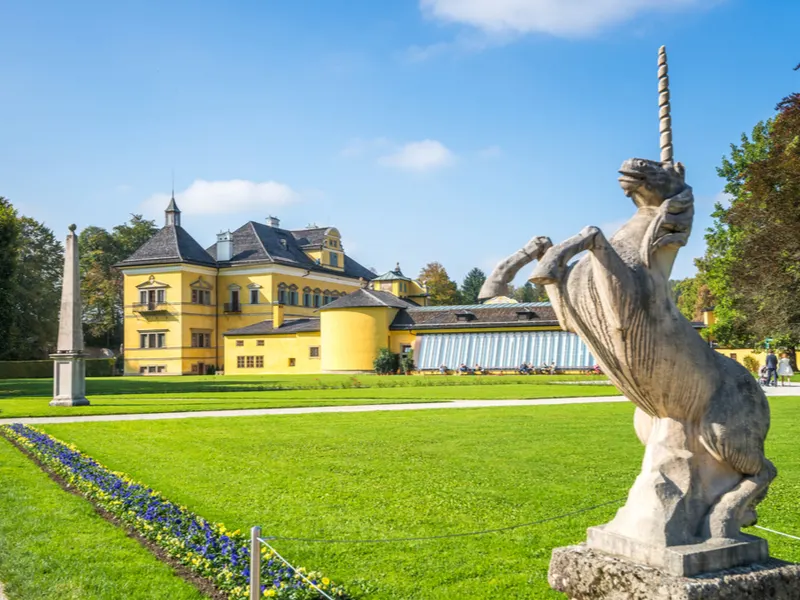
Sina Ettmer Photography/Shutterstock
That’s everything you need to know to help plan your Sound of Music-inspired vacation. Here are some other questions people often ask as they outline their trip:
Can I visit the Sound of Music house?
Yes. There are three locations that visitors interested in the house from the Sound of Music can seek out. These include:
- Schloss Leopoldskron
- Frohnburg Palace
- Villa Trapp in Aigen
Is the Sound of Music Gazebo real?
The gazebo featured in The Sound of Music was real and can be visited. However, the version most accessible to visitors is a reconstruction of Hellbrunn Palace. Many Sound of Music tours include the gazebo as a stop on the tour.
Where can I find the filming locations used in The Sound of Music?
Many of the filming locations for The Sound of Music are in Salzburg. However, some of the shots come from slightly further afield. You can still visit them, but places like Mondsee may benefit from day trips out of Salzburg.
Where is the hill from the Sound of Music?
Although many of the other locations are in Salzburg, Austria, the iconic hill is located on the German alps near the Austrian border.
Is the Von Trapp family real?
Yes, they were a real family. While some of the story is fictionalized for the movie, the overall family and plot is based on a real family.
Which The Sound of Music Filming Location Will You Visit?
There’s a variety of The Sound of Music film locations for fans to visit. How you decide which ones to prioritize is a matter of taste. All of them have fascinating histories, views, and interiors, so there are no wrong choices.
Don’t forget to investigate opening times, and pack suitable clothes for your trip. You want to enjoy it as much as possible. Finally – don’t hesitate to do a bit of singing. The hills might be alive with it, but they always welcome harmony.



